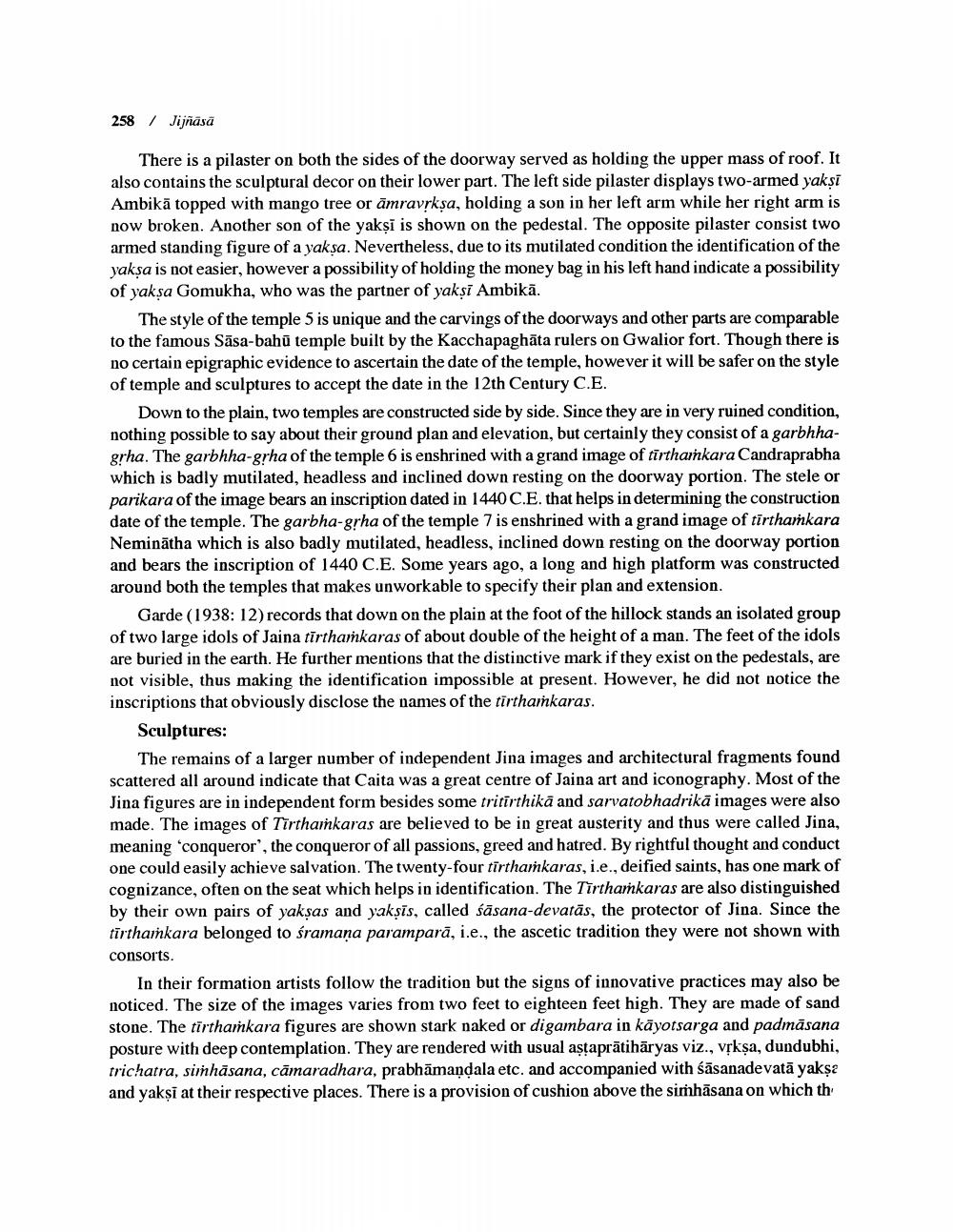________________
258 / Jijñāsä
There is a pilaster on both the sides of the doorway served as holding the upper mass of roof. It also contains the sculptural decor on their lower part. The left side pilaster displays two-armed yakși Ambikā topped with mango tree or āmravskşa, holding a son in her left arm while her right arm is now broken. Another son of the yakşi is shown on the pedestal. The opposite pilaster consist two armed standing figure of a yaksa. Nevertheless, due to its mutilated condition the identification of the yaksa is not easier, however a possibility of holding the money bag in his left hand indicate a possibility of yakşa Gomukha, who was the partner of yakși Ambikā.
The style of the temple 5 is unique and the carvings of the doorways and other parts are comparable to the famous Sāsa-bahū temple built by the Kacchapaghāta rulers on Gwalior fort. Though there is no certain epigraphic evidence to ascertain the date of the temple, however it will be safer on the style of temple and sculptures to accept the date in the 12th Century C.E.
Down to the plain, two temples are constructed side by side. Since they are in very ruined condition, nothing possible to say about their ground plan and elevation, but certainly they consist of a garbhhagrha. The garbhha-grha of the temple 6 is enshrined with a grand image of tirthamnkara Candraprabha which is badly mutilated, headless and inclined down resting on the doorway portion. The stele or parikara of the image bears an inscription dated in 1440 C.E. that helps in determining the construction date of the temple. The garbha-grha of the temple 7 is enshrined with a grand image of tirthamkara Neminātha which is also badly mutilated, headless, inclined down resting on the doorway portion and bears the inscription of 1440 C.E. Some years ago, a long and high platform was constructed around both the temples that makes unworkable to specify their plan and extension.
Garde (1938: 12) records that down on the plain at the foot of the hillock stands an isolated group of two large idols of Jaina tirthaikaras of about double of the height of a man. The feet of the idols are buried in the earth. He further mentions that the distinctive mark if they exist on the pedestals, are not visible, thus making the identification impossible at present. However, he did not notice the inscriptions that obviously disclose the names of the tirthaikaras.
Sculptures:
The remains of a larger number of independent Jina images and architectural fragments found scattered all around indicate that Caita was a great centre of Jaina art and iconography. Most of the Jina figures are in independent form besides some tritirthikā and sarvatobhadrikā images were also made. The images of Tirtharkaras are believed to be in great austerity and thus were called Jina, meaning 'conqueror', the conqueror of all passions, greed and hatred. By rightful thought and conduct one could easily achieve salvation. The twenty-four tirthamkaras, i.e., deified saints, has one mark of cognizance, often on the seat which helps in identification. The Tirtharkaras are also distinguished by their own pairs of yakşas and yaksis, called śāsana-devatās, the protector of Jina. Since the tirthamkara belonged to śramana paramparā, i.e., the ascetic tradition they were not shown with consorts.
In their formation artists follow the tradition but the signs of innovative practices may also be noticed. The size of the images varies from two feet to eighteen feet high. They are made of sand stone. The tirthamnkara figures are shown stark naked or digambara in käyotsarga and padmāsana posture with deep contemplation. They are rendered with usual astaprätihäryas viz., vrksa, dundubhi, trichatra, simhäsana, camaradhara, prabhāmandala etc. and accompanied with śäsanadevatā yakşa and yakși at their respective places. There is a provision of cushion above the simhāsana on which th




